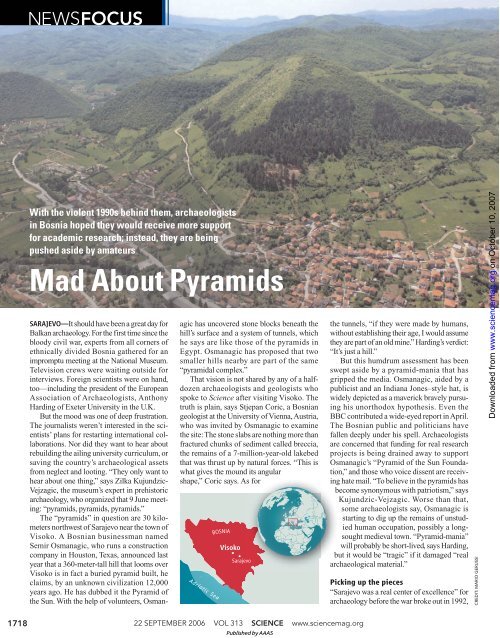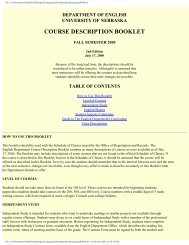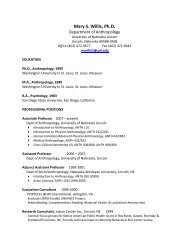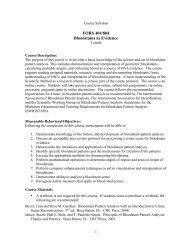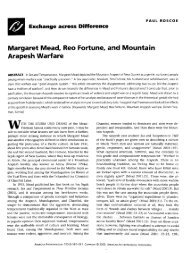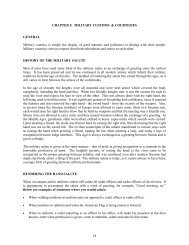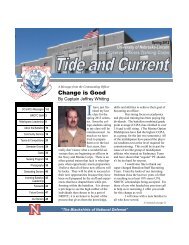Mad About Pyramids
Mad About Pyramids
Mad About Pyramids
You also want an ePaper? Increase the reach of your titles
YUMPU automatically turns print PDFs into web optimized ePapers that Google loves.
1718<br />
NEWSFOCUS<br />
With the violent 1990s behind them, archaeologists<br />
in Bosnia hoped they would receive more support<br />
for academic research; instead, they are being<br />
pushed aside by amateurs<br />
<strong>Mad</strong> <strong>About</strong> <strong>Pyramids</strong><br />
SARAJEVO—It should have been a great day for<br />
Balkan archaeology. For the first time since the<br />
bloody civil war, experts from all corners of<br />
ethnically divided Bosnia gathered for an<br />
impromptu meeting at the National Museum.<br />
Television crews were waiting outside for<br />
interviews. Foreign scientists were on hand,<br />
too—including the president of the European<br />
Association of Archaeologists, Anthony<br />
Harding of Exeter University in the U.K.<br />
But the mood was one of deep frustration.<br />
The journalists weren’t interested in the scientists’<br />
plans for restarting international collaborations.<br />
Nor did they want to hear about<br />
rebuilding the ailing university curriculum, or<br />
saving the country’s archaeological assets<br />
from neglect and looting. “They only want to<br />
hear about one thing,” says Zilka Kujundzic-<br />
Vejzagic, the museum’s expert in prehistoric<br />
archaeology, who organized that 9 June meeting:<br />
“pyramids, pyramids, pyramids.”<br />
The “pyramids” in question are 30 kilometers<br />
northwest of Sarajevo near the town of<br />
Visoko. A Bosnian businessman named<br />
Semir Osmanagic, who runs a construction<br />
company in Houston, Texas, announced last<br />
year that a 360-meter-tall hill that looms over<br />
Visoko is in fact a buried pyramid built, he<br />
claims, by an unknown civilization 12,000<br />
years ago. He has dubbed it the Pyramid of<br />
the Sun. With the help of volunteers, Osman-<br />
agic has uncovered stone blocks beneath the<br />
hill’s surface and a system of tunnels, which<br />
he says are like those of the pyramids in<br />
Egypt. Osmanagic has proposed that two<br />
smaller hills nearby are part of the same<br />
“pyramidal complex.”<br />
That vision is not shared by any of a halfdozen<br />
archaeologists and geologists who<br />
spoke to Science after visiting Visoko. The<br />
truth is plain, says Stjepan Coric, a Bosnian<br />
geologist at the University of Vienna, Austria,<br />
who was invited by Osmanagic to examine<br />
the site: The stone slabs are nothing more than<br />
fractured chunks of sediment called breccia,<br />
the remains of a 7-million-year-old lakebed<br />
that was thrust up by natural forces. “This is<br />
what gives the mound its angular<br />
shape,” Coric says. As for<br />
Adriatic Sea<br />
BOSNIA<br />
Visoko<br />
Sarajevo<br />
22 SEPTEMBER 2006 VOL 313 SCIENCE www.sciencemag.org<br />
Published by AAAS<br />
the tunnels, “if they were made by humans,<br />
without establishing their age, I would assume<br />
they are part of an old mine.” Harding’s verdict:<br />
“It’s just a hill.”<br />
But this humdrum assessment has been<br />
swept aside by a pyramid-mania that has<br />
gripped the media. Osmanagic, aided by a<br />
publicist and an Indiana Jones–style hat, is<br />
widely depicted as a maverick bravely pursuing<br />
his unorthodox hypothesis. Even the<br />
BBC contributed a wide-eyed report in April.<br />
The Bosnian public and politicians have<br />
fallen deeply under his spell. Archaeologists<br />
are concerned that funding for real research<br />
projects is being drained away to support<br />
Osmanagic’s “Pyramid of the Sun Foundation,”<br />
and those who voice dissent are receiving<br />
hate mail. “To believe in the pyramids has<br />
become synonymous with patriotism,” says<br />
Kujundzic-Vejzagic. Worse than that,<br />
some archaeologists say, Osmanagic is<br />
starting to dig up the remains of unstudied<br />
human occupation, possibly a longsought<br />
medieval town. “Pyramid-mania”<br />
will probably be short-lived, says Harding,<br />
but it would be “tragic” if it damaged “real<br />
archaeological material.”<br />
Picking up the pieces<br />
“Sarajevo was a real center of excellence” for<br />
archaeology before the war broke out in 1992,<br />
CREDIT: MARIO GERUSSI<br />
on October 10, 2007<br />
www.sciencemag.org<br />
Downloaded from
CREDIT: MARIO GERUSSI<br />
Human design? The hill that looms over Visoko<br />
resembles a pyramid.<br />
says Harding. But during 4 years of nonstop<br />
shelling, “we nearly lost everyone and everything,”<br />
says Kujundzic-Vejzagic, who fled to<br />
Croatia a year into the conflict.<br />
Archaeological sites were used as defensive<br />
positions in fierce battles, and shattered<br />
windows left the museum vulnerable to winter<br />
weather and animals. The timing could<br />
not have been worse, says Preston Miracle,<br />
an archaeologist at the University of Cambridge,<br />
U.K., who has worked in the region<br />
for 2 decades. Just before the war, he says,<br />
“the senior generation of Bosnian prehistorians<br />
all died,” and the generation in line to<br />
replace them scattered.<br />
Ten years on, the community still has not<br />
recovered, “but at least it is clear what needs to<br />
be done to get us back in shape,” says<br />
Kujundzic-Vejzagic, who returned in 1998<br />
and has remained at her post in Sarajevo. The<br />
first priority is “to assess and protect” the<br />
endangered archaeological riches in the country,<br />
now known as Bosnia and Herzegovina.<br />
This roughly Switzerland-sized territory has<br />
been continuously occupied all the way back<br />
to the last Ice Age and beyond.<br />
Little is known about the first Slavic<br />
tribes that arrived some 1500 years ago, says<br />
Kujundzic-Vejzagic. Even less is known<br />
about the people who preceded them,<br />
the Illyrians, who held sway from around<br />
1300 B.C.E. until the Romans took over.<br />
Learning more about their interactions with<br />
neighboring cultures, especially the Greeks,<br />
would shed light on the technological revolutions<br />
that changed Bronze and Iron Age<br />
Europe. “All of these settlements and graves<br />
are just waiting to be studied,” she says,<br />
although “we’d do better to leave everything<br />
in the ground” until resources are secured to<br />
protect against weather and looters.<br />
Deeper in time, fundamental questions<br />
about Neolithic society have sustained one<br />
of the few remaining international collaborations<br />
in Bosnia. Over the past 4 years, a<br />
team led by Kujundzic-Vejzagic and<br />
Johannes Müller, an archaeologist at the<br />
University of Kiel, Germany, has been<br />
exploring a site near the town of Okoliste, 7 km<br />
away from the pyramid hunt. It has been<br />
identified as part of the Butmir culture, a<br />
source of richly decorated pottery and intricate<br />
statuettes discovered in 1893. Research<br />
on these artifacts and related 7000-year-old<br />
dwelling sites could help answer one of the<br />
central questions of prehistoric archaeology,<br />
says Müller: “How and why did we go from<br />
simple, egalitarian societies of small settle-<br />
ments to complex, hierarchical societies<br />
with big, dense settlements?”<br />
Buried in the soil near Okoliste are the<br />
remains of the largest Neolithic settlement<br />
ever found in Europe: between 200 and<br />
300 houses protected by a ring of three<br />
trenches and a raised bank. “I was astonished<br />
when I realized that this defended area<br />
alone could have been home to as many as<br />
3000 people,” Müller says. Settlements from<br />
contemporary Neolithic cultures in Europe<br />
were occupied by no more than 300.<br />
Another research team, led by Miracle and<br />
Tonko Rajkovaca, a Bosnian archaeologist<br />
also at Cambridge, has just begun looking for<br />
traces of even earlier human occupation in<br />
northern Bosnia; the area is thought to be<br />
one of the last refuges of the Neandertals.<br />
“Despite the richness of this record,” says<br />
Miracle, the region “remains poorly known<br />
and understood.”<br />
With relatively untapped heritage<br />
resources, academic archaeologists say, the<br />
Bosnian government should be trying to help<br />
in any way possible. But instead, many<br />
researchers feel that the country is turning<br />
against them.<br />
When hills become pyramids<br />
If you stand in the right place in Visoko, the<br />
largest of the nearby hills almost looks like a<br />
pyramid. At least, two of its sides are more or<br />
less flat, although the rest is lumpy. During a<br />
tour of the site by Science in June, freshly<br />
dug earthen stairs led up the slope through<br />
the trees, slick with rain. Along the way up,<br />
NEWSFOCUS<br />
broad patches of soil had been cut away and<br />
roped off with yellow tape. A pair of local<br />
guides pointed to the exposed crust of fractured<br />
rock and explained, “This is the side of<br />
the Pyramid of the Sun.” And pointing to two<br />
smaller hills across the valley: “That is the<br />
pyramid of the dragon, and that one is the<br />
pyramid of the moon.”<br />
Osmanagic, who came up with the hills’<br />
mythical names, says he became convinced in<br />
April 2005 that they are buried pyramids,<br />
based on their shape and position. Osmanagic<br />
is in love with pyramids. He says he has studied<br />
“hundreds” of them around the world—<br />
including the Mayan pyramids, which in his<br />
view were located and built with “vibrational”<br />
Big dig. Semir Osmanagic (in hat) and Ivica ˘Sarić, Sarajevo’s minister of culture, with volunteer excavators<br />
at the “pyramid” site. Archaeologists worry that valuable material may be stripped away.<br />
technology inherited from the lost civilizations<br />
of “Atlantis and Lemuria.”<br />
He says he has sought the help of experts<br />
to make “serious scientific argumentation.”<br />
One of the first was Amer Smailbegovic, a<br />
geophysicist who runs a surveying company<br />
and teaches at the International University of<br />
Sarajevo. “I noticed that the area has a peculiar<br />
triangular-sided feature you don’t see too<br />
often in a temperate environment,” says<br />
Smailbegovic, who analyzed satellite<br />
imagery for Osmanagic. Thermal and radar<br />
imaging also made the hill seem “out of the<br />
ordinary,” he says. So Smailbegovic wrote to<br />
Osmanagic that “there are anomalies present<br />
in your area of interest, and you may have<br />
something there. I suggest you find yourself<br />
an archaeologist and geologist to help you<br />
validate the area.” But “the next thing I<br />
know,” Smailbegovic says, “there was a<br />
www.sciencemag.org SCIENCE VOL 313 22 SEPTEMBER 2006 1719<br />
Published by AAAS<br />
on October 10, 2007<br />
www.sciencemag.org<br />
Downloaded from
NEWSFOCUS<br />
1720<br />
headline in the Bosnian papers: Satellite<br />
imagery confirms Osmanagic’s discovery of<br />
pyramids in Bosnia.” This would prove to be the<br />
start of a barrage of “sensationalism,” he says.<br />
Osmanagic says he invested $20,000 of<br />
his own money to hire dozens of people,<br />
including a public relations manager, and<br />
established a tax-exempt foundation to pay<br />
them. He also placed an advertisement in the<br />
listings of the Archaeological Institute of<br />
America for someone who could do Paleolithic<br />
fieldwork. Among those who<br />
responded was Royce Richards, an archaeologist<br />
who works for the Australian government<br />
as a heritage officer in Adelaide.<br />
In January, “things got very strange,” says<br />
Richards. In newspaper articles around the<br />
world, he was named as one of the main<br />
“expert advisers” on an international dig that<br />
has discovered “evidence of Bosnian pyramids.”<br />
Osmanagic’s foundation Web site had<br />
included Richards in the “advisory committee<br />
of experts,” even though he never visited<br />
Bosnia nor confirmed that he would participate.<br />
Other academics say they were listed<br />
although they had never asked to be involved.<br />
One of them, Bruce Hitchner, head of the<br />
archaeology program at Tufts University in<br />
Medford, Massachusetts, objected when he<br />
learned that his name had been hijacked.<br />
Osmanagic has removed all the expert advisers’<br />
names from his Web site but<br />
says, “I did nothing wrong.”<br />
Smailbegovic visited Visoko<br />
in April to see the project for himself.<br />
“The situation was chaotic,”<br />
he says. Osmanagic’s volunteers<br />
are digging up the area, but<br />
Smailbegovic didn’t see much<br />
effort directed at “answering the<br />
question of why there are geospatial<br />
anomalies in the Visoko<br />
valley.” Smailbegovic and other<br />
geologists conducted their own<br />
field study of the Visoko valley in<br />
May and June. He says Osmanagic<br />
has ignored their detailed reports,<br />
which conclude that natural<br />
forces created “the majority of<br />
the landscape features” and that<br />
“meticulous archaeological<br />
work” is needed to determine<br />
whether humans had any part in it.<br />
Osmanagic says he is doing<br />
just that, but archaeologists are<br />
outraged. “This is the equivalent<br />
of letting me, an archaeologist,<br />
perform surgery in hospitals,”<br />
says Enver Imamovic of the University<br />
of Sarajevo, a former<br />
director of the National Museum.<br />
By assuming that the hills are pyramids from<br />
the very start, says Müller, “that’s all he’ll<br />
ever see.” For example, he points out, Osmanagic’s<br />
deduction of the age of the pyramids at<br />
12,000 years old is based on nothing more<br />
than the depth of the soil over the stones that<br />
he claims are masonry. While clearing away<br />
that soil, Osmanagic’s volunteers have found<br />
engraved stones and a skeleton. Imamovic<br />
worries that these may be signs of a longsought<br />
necropolis or a lost town mentioned in<br />
Byzantine texts. Osmanagic says the skeleton<br />
“is being analyzed,” but he believes it was<br />
recently interred.<br />
Osmanagic also says he has uncovered a<br />
stone layer that is “the pyramid’s face” on one<br />
of the smaller hills. A European archaeologist<br />
working in Bosnia who had a look for himself<br />
says, “There is a real wall there, but it looks to<br />
me like part of a small Middle Age rain reservoir.”<br />
The archaeologist, who requested<br />
anonymity for fear of losing permission to<br />
work in the country, says he is not surprised<br />
that diggers have uncovered signs of human<br />
occupation: “People have been here for millennia.”<br />
But after Osmanagic is done with<br />
Visoko, “we may never know what was really<br />
here,” he says. The real archaeological material<br />
is between the surface and the bedrock, he<br />
says, “but for a pyramid-hunter, that is just dirt<br />
to strip away.”<br />
The real thing. Archaeologist Zilka Kujundzic-Vejzagic holds a pot<br />
from the Butmir culture that flourished in Bosnia 7000 years ago.<br />
22 SEPTEMBER 2006 VOL 313 SCIENCE www.sciencemag.org<br />
Published by AAAS<br />
Osmanagic says he is aware that he is digging<br />
through layers of occupation and claims<br />
he will publish his results “in a peer-reviewed<br />
journal” in November. “But I am not interested<br />
in the approval of elite scientists. This<br />
project is for the people.”<br />
Popular archaeology<br />
In spite of the protests from academic quarters,<br />
public and political support for Osmanagic<br />
seems to be growing. The government<br />
has granted him all the necessary permits and<br />
has even helped finance his excavations. “It is<br />
shocking” that public funds are flowing to<br />
Osmanagic instead of the country’s desperate<br />
archaeologists, says Müller. But Osmanagic<br />
says that only 10% of his current budget—the<br />
total is about $300,000, he says—comes from<br />
government support, while the rest is from<br />
“private funds and corporate sponsors.”<br />
One expert says it’s easy to understand why<br />
people seeking a national identity would<br />
embrace the Visoko phenomenon. “Osmanagic’s<br />
pyramid fantasies are exactly what the<br />
majority of Bosnians want to hear,” explains a<br />
Bosnian sociologist who spoke on condition<br />
of anonymity. There are also economic motivations.<br />
Last month, Osmanagic announced<br />
plans to build three “archaeological parks”<br />
across the country that will “rewrite world history”<br />
by revealing more evidence of Bosnia’s<br />
prehistoric “supercivilization.” New highways<br />
and hotels are part of the plan.<br />
Crude as it may seem, pyramid-mania<br />
could be a boon over the long term, says<br />
Miracle: “If the energy and interest in<br />
archaeology can be redirected into Bosnia’s<br />
rich heritage, then this affair would not be<br />
such a fiasco after all.” But few are optimistic.<br />
Kujundzic-Vejzagic says she is on<br />
the verge of quitting. She says she’s been the<br />
target of hate mail from the pro-pyramid<br />
movement; no one in government has<br />
stepped forward to defend her. If she goes,<br />
the entire Butmir project will probably fold,<br />
says Müller. “There is no other prehistoric<br />
archaeologist in the country,” he says. “She<br />
is our only partner.” Bosnia’s other archaeologists<br />
are in an equally precarious position.<br />
A Visoko municipal official recently<br />
announced that all critics of Osmanagic’s<br />
project should be denied access to research<br />
locations and have their degrees revoked.<br />
Descending the hill back down to Visoko,<br />
a visitor wades through the friendly locals<br />
selling official “Pyramid of the Sun” T-shirts<br />
and mugs. One thing is clear: Some people<br />
will benefit from the hunt for a prehistoric<br />
Bosnian civilization. But they may not be<br />
academic archaeologists.<br />
–JOHN BOHANNON<br />
CREDIT: J. BOHANNON/SCIENCE<br />
on October 10, 2007<br />
www.sciencemag.org<br />
Downloaded from


